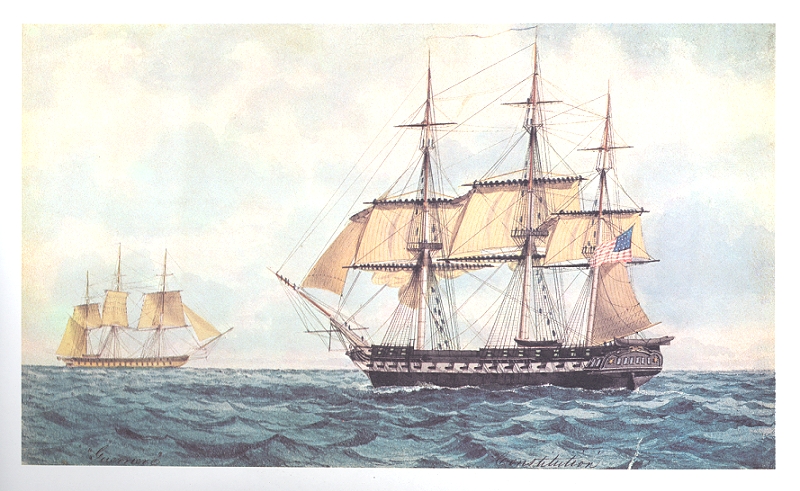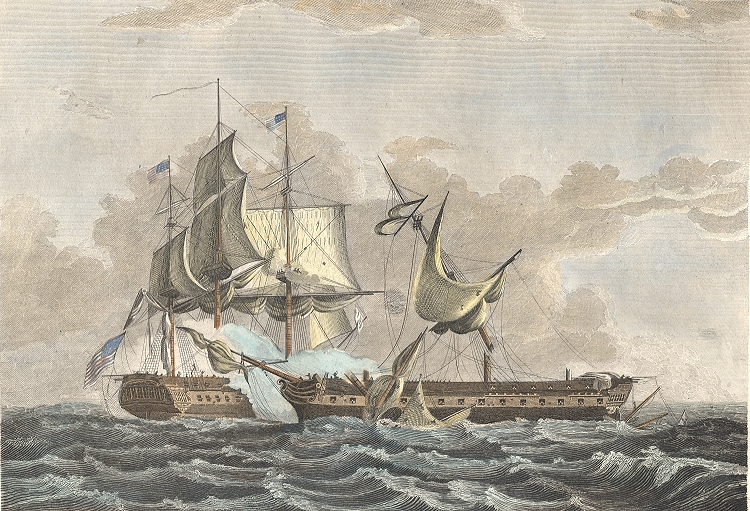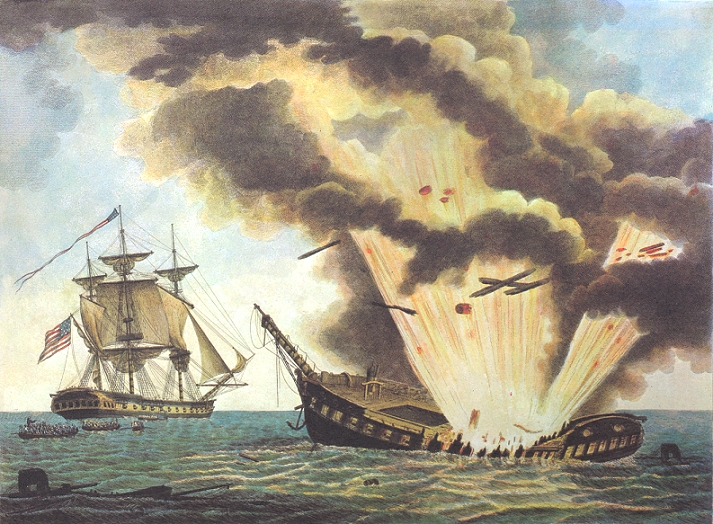
 Book #2: Settlement, Revolution & War.
Book #2: Settlement, Revolution & War.
It was the 19th of August, 1812, and Captain Isaac Hull (1773-1843) was on the quarterdeck of the 44-gun, USS Constitution.1 In a soft confidential voice he told his first officer that maybe now they could go along a little easier and have some of the men stand down. It had been a long chase but they had outrun a British squadron. The Constitution now had the clear light of day and there was no sign of a British sail. The day before things were not looking so good as a fleet of British ships were in hot pursuit. Was it the pitch black moonless night that had saved them? Maybe their superior sailing abilities?
The course was set and the breeze steady, thus, to a degree, the sails could take care of themselves. Captain Hull might have retired to his cabin as there was the ship's journal to be written up. He continued to lean on the quarterdeck rail and observed his seamen taking their ease. Some of them were in groups, some off by themselves. It was quiet. Then a cry went out from the topman, a cry together with a thrusted arm to the northwest. All knew he had spotted another sail or sails. Who could it be? The British squadron had been left behind to the southeast. Quickly, each officer who had a glass had it up to his eye. Hull was the first to snatch it from his face and then to smartly snap it telescopically shut between his hands, an action which brought all eyes on the deck to him. It looked like the Constitution might have a British ship under her lee.2
She was, as her name suggests, a French warship. She was taken by the British in 1806 and re-fitted out at Chatham. John Liddell -- the journal-keeping merchant at Halifax to whom we have referred in this part on a number of occasions -- made a note of her on July 5th, in 1810, "HMS Guerrière comes in from cruise." And on November 9th, "HMS Guerrière go on a cruise." Through the years 1811-1812, she continued to work out of the Halifax and Bermuda stations. In 1811, (April 11th) she had received a new captain, the twenty-three year old, James Richard Dacres.3 On the day that the Constitution spied her, August 19th, 1812, the Guerrière was "600 miles S.E. of Halifax"4 making her way along in a fresh breeze. She and her crew of 263 were headed for Halifax where she was going to undergo a refit. It was early morning when the ships came in sight of one another, but it was 3:30 P.M. before each knew who they were dealing with. Both cleared for action5, and by 4:30 P.M.

|
| A Copy of a Watercolor by W.A.K. Martin. |
"... The Guerrière backed her main-topsail [and] having hoisted an English ensign at the peak, another at the mizen-topgallant masthead, and a union-jack at the fore, opened her starboard broadside upon the Constitution; then filling and wearing round, she fired her larboard broadside; but the shots are described by Captain Hull as having fallen short. This would say very little in favour of the skill of the British crew, were it not known that the powder was of very inferior quality. At 5h. 5m., the Constitution, with an American ensign at the peak, another in the larboard mizen shrouds, and a third at the fore, having arrived upon the weather beam of the Guerrière, opened her fire with great precision."6The Guerrière, her shots not finding their targets, resorted to sailing out of trouble. Within the half hour she switched her course coming about stern-first through the wind, desperately trying to position herself and, above all, trying to avoid being raked, that is, receiving a broadside from her adversary that carried along the length of her. She did all she could to avoid having her bow or her stern pointing to the thick broadside of the Constitution. Soon, however both ships were running side by side and brought "to close action." In short order the Guerrière's mizzenmast7 was completely cut through by shot. The rigging lines kept the mizzen attached to the Guerrière, with the works (lines, spars, torn sails, flags, etc.) bent over from the side of the Guerrière. The works dragged in the water along side of her, with the lines tangling the tillerless rudder. The Guerrière headed unmanageably off course into the wind and slowed; the Constitution lost no time in positioning herself on the bow of the British ship and raked her.

|
| Painted by T. Birch and engraved by Kimberly. |
At 6:15 P.M. the two ships fell on board each other, the bowsprit of the Guerrière becoming entangled with the starboard mainrigging of the Constitution. An attempt was now made by the Americans to board, when a shot from a British marine brought down the leader, the first lieutenant of marines; her first lieutenant was also shot, and the last wounded in the shoulder. The American marines, however, were not idle. From the tops they fired upon the Guerrière's officers and men with deadly aim.8With the dead and the dying lying on their decks, the Constitution and the Guerrière continued their destructive dance. The combatants dropped clear of each other. The Guerrière fired her cannons once again but her cannonballs were of no effect, wadding from her cannons did more damage as a small fire erupted on the Constitution's deck, presumably put out quickly by the bucket brigade.

|
| Painted by Montardier du Havre and engraved by Baugean. |
Rolling heavily, her gunports admitting waves of water, the Guerrière was in a defenceless state. Captain Dacres called his remaining officers together. A decision was taken to strike their colours. A lee gun was fired, and the union-jack hauled down from the stump of the mizzenmast.
The "butcher's bill:" out of a crew 263, the Guerrière had 15 killed and 63 wounded (six mortally so); the Constitution, out of 476, seven and seven.10 The Guerrière was beyond fixing, so, after taking out the British sailors11, the Americans set the Guerrière on fire. The Constitution then headed into Boston with a throng of people on her deck. A good number of Guerrière's crew, I suspect, never made it back to the deck of a British ship. A court martial was held at Halifax on October 2nd on board the 64-gun Africa, I suppose the most senior British warship then at Halifax. The finding was that Captain Dacres was justified in surrendering his ship to save the lives of her remaining crew. The court also found that the masts going overboard were "due more to their defective nature than the fire of the enemy."12
A reasonable conclusion is this: The Guerrière was destroyed by the Constitution, likely because the guns of the Constitution simply had better range and did more damage to the Guerrière, so that, minutes later, when the ships were fighting side by side, "yardarm to yardarm," (close-in fighting was always what the British navy strove for), a good part of her was already shot away. Simply put, the Constitution had greater strength and better resistance.
The Score Mounts up in Favour of the Americans
We have now written of the American successes: the battering of the Little Belt by the President in 1811, the American Fleet chasing the Belvidera in June of 1812, and the capture and burning of the Guerrière in August of 1812. There were other American successes not so close to home to which I shall now but briefly refer.
On December the 24th, 1812, departing from the East India Company ships which she had brought across the Atlantic, the 38-gun Java13 went for the coast of Brazil for water. On the 29th, she came into the sights of the 44-gun14, American frigate Constitution, with the number of officers and men closing in on 500. William Bainbridge was then her captain having succeeded Isaac Hull. The ensuing battle turned the Java into a floating wreck. She had lost 31 killed and 103 wounded15, one of whom was Captain Henry Lambert who died a few days later after having been landed at Salvador, Brazil. The Americans had 10 killed and 48 wounded.16
Then there was the encounter between HMS Peacock and the USS Hornet towards the end of February, 1813. The 20-gun USS Hornet had been ordered to cruise the waters northeast of South America. Information had come to her captain, James Lawrence (we will be reading about him soon again), that tucked in the mouth of the Demarara River (Guiana) there was lying a British warship of about equal size, the Espiègle. The Hornet was keen to take her. But first it was necessary to clear Cape Caroband. The Hornet was hard on the wind in trying to clear Cape Caroband. It's hard sailing against the wind, -- in fact, a sailing vessel cannot directly do so. The crew is obliged to make the sailing vessel zigzag, back and forth, back and forth, and, every time, the sailors must pull on ropes hand over hand. When sailing to windward a sailor, with each new tack, must reset all lines and adjust all sails -- it's hard work. The men of the Hornet need not have worked so hard, for as soon as the Hornet rounded the Cape there came a British man-o'-war, she was aiming right for them. It seems the Espiègle had company at her anchorage, the Peacock, another 18 gun brig.17 The captain of the Peacock, Captain William Peake was meaning to deal with the Hornet.
Admiral Mahan wrote, the "capture of the Peacock was the last of five naval duels, three between frigates and two between sloops, all favorable in issue to the United States ..."22 Things were due for a change.
The pride of the British Navy was being hurt. The British Navy had been superior to any other for decades and only -- just in 1805 -- broke the navies of two nations (France and Spain) in one victorious battle off Cape Trafalgar. And here, in the years 1811 to 1813, the Americans, with hardly a navy, were knocking off British warships one after the other. Admiral Warren sent out orders for the ships to double up and bring on their cruises, in addition, a sloop for reconnoitering and delivering dispatches.23 Warren also wrote the Admiralty back in London: he wanted more ships. "They [the Admiralty] remind him that he has under his flag eleven sail of the line, thirty-four frigates, thirty-eight sloops, besides other vessels, making a total of ninety-seven."24
In falling astern of her adversary, the bowsprit of the Guerrière's came in contact with the Constitution's taffrail, and the foremast and mainmast of the British frigate almost immediately afterwards fell over the starboard side.9
With every stick standing, the Constitution wore round and positioned herself within a pistol-shot of the starboard quarter of the Guerrière. The Constitution made ready to administer the coup de grace. Her gun crews stood still, the lead hand looking to the gunnery officer. A period of almost absolute quiet followed. The crews of both ships waited.

Painted by J.J. Barralet and engraved by B. Tanner.
"At 4:20 P.M. the Peacock bore down upon the Hornet, and hoisted her colours; and at 5h. the Hornet came round on the starboard tack and also hoisted her colours. At 5h. 25m., the corvette and brig, passing on opposite tacks, exchanged broadsides. The Peacock then wore round under the stern of the Hornet, and engaged her to leeward; but, after receiving the Peacock's broadside, the Hornet bore up and ran her on board on the starboard quarter. In this position the Hornet kept up such a destructive fire, that, at 5 h. 50m., having her commander killed, six feet water in her hold, and her hull and masts cut to pieces, the Peacock hoisted in her fore-rigging an ensign with the union downwards, as a signal of distress. Shortly afterwards her mainmast went by the board. Both vessels were immediately anchored, and every exertion was used to save the Peacock; but the efforts of both crews were unavailing, and in a few minutes she sank in five fathoms water, carrying with her thirteen men, only four of whom were rescued."18
In the exchange, out of a crew of 110 on the Peacock, five were killed, including her captain, twenty-nine were wounded. "The Hornet received some trifling damage in her spars19; and, out of 163 men and boys, had one man killed and two slightly wounded." It was a proud day for Captain Lawrence and his crew, however it has to be remembered that the Hornet had more guns and, more importantly, heavier guns: "eighteen 32-pounders," versus, "sixteen 24-pounders."20 Though it needs to be said that the crew of the Peacock might have performed differently if they had spent more time practicing at her guns than in shining her brass-ware. In quoting from William James' classic work, Mahan wrote, "Neglect to exercise the ship's company at the guns prevailed then over two thirds of the British navy; to which the Admiralty, by their sparing allowance of power and shot for practice, were in some degree instrumental."21
[NEXT: Pt. 5, Ch. 11 -- "The Shannon and the Chesapeake," Part 1.]
